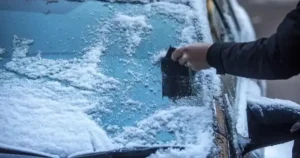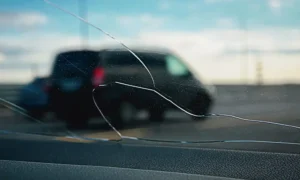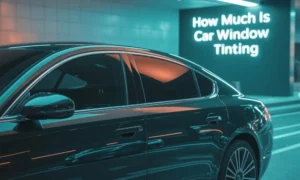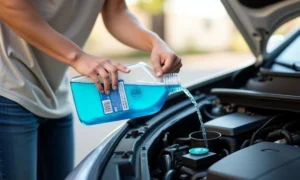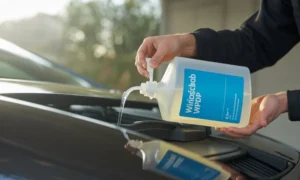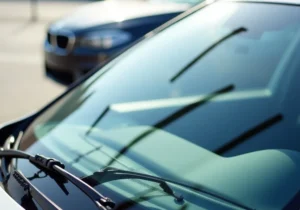Can you tint your windshield? Yes, but with very specific limits depending on where you live. In addition to keeping your car cooler, a tinted windscreen can assist cut down on glare and filter dangerous UV rays. However, windshield tinting also raises important questions about road safety, visibility at night, and—most importantly—legal compliance. In many states, including Texas, there are strict rules about how much of your windshield can be tinted and how dark that tint can be. Drivers must follow these laws to avoid fines, inspection issues, or even orders to remove the tint. Texas, in particular, has clear regulations about where and how windshield tinting is allowed, especially when it comes to the front windshield and visibility lines like the AS-1 mark.
Can You Tint Your Windshield?
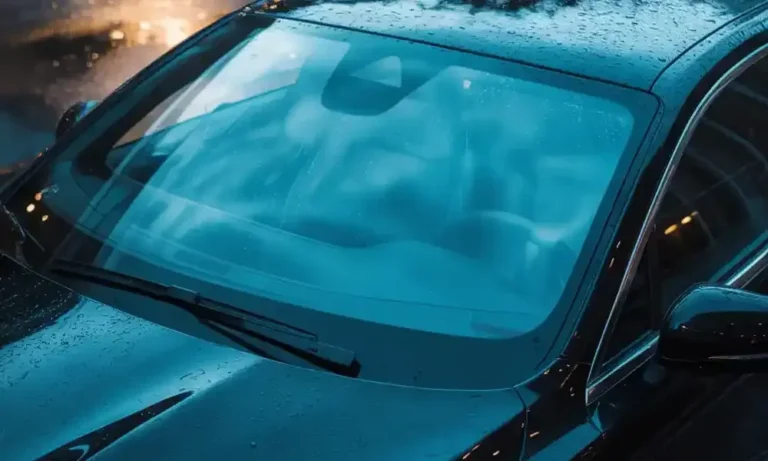
It is legal to tint your windscreen, but only in certain circumstances. Most U.S. states permit front windshield tint as long as it meets visibility standards and doesn’t interfere with driver safety. The key is knowing how much tint is legal where you live.
Federal vs. State Laws on Windshield Tinting
Federal Guidelines:
The Federal Motor Vehicle Safety Standards (FMVSS) require all auto glass to allow at least 70% of visible light transmission (VLT). This guarantees that drivers can see clearly, particularly in bad weather or at night.
State-Specific Laws:
States interpret these federal guidelines differently. For example:
- California only permits a 4-inch non-reflective tint strip on the front windscreen.
- Texas also permits a 5-inch strip or above the AS-1 line (whichever is more restrictive).
- Florida requires at least 70% VLT on the windshield.
Check your state’s Department of Transportation or DMV website to know what’s allowed in your area.
Common Types of Windshield Tints
Knowing your alternatives is helpful if you’re thinking about tinting your windscreen:
1. Ceramic Tint
- High heat rejection
- UV and glare protection
- No signal interference
- More expensive but offers superior clarity
2. Dyed Film
- Least expensive option
- Absorbs heat and reduces glare
- Wears out faster and may fade over time
3. Clear UV Films (Invisible Tint)
- No dark shade—keeps the windshield clear
- Blocks up to 99% of UV rays
- Ideal if you want protection without darkening
Because they adhere to visibility regulations, these are frequently used for legal front windscreen tinting.
Benefits of Tinting a Windshield
- Blocks harmful UV rays
- Reduces glare from sunlight and headlights
- Keeps your car cooler
- Protects your dashboard and interior from fading
- Enhances comfort and safety
You can also read about Different Types Of Auto Window Tint.
Can You Tint Your Front Windshield in Texas?
Yes, you can tint your front windscreen in Texas, but you have to abide by certain rules.
Texas Law on Front Windshield Tint
Only the upper part of the windscreen may have front windscreen tint, according Texas Transportation Code 547.613. Usually encompassing the upper five inches of the glass, this region is referred to as the AS-1 line. Any tint below this line is not allowed unless it meets very specific conditions.
What Type of Tint is Allowed?
- Non-reflective tint is required above the AS-1 line.
- The colour of the tint cannot be blue, amber, or red.
- No tint is permitted below the AS-1 line on the front windshield, unless you have a medical exemption.
Medical Exemption for Windshield Tinting
Texas does permit some people to request for a medical exemption if they have specified medical conditions. If approved, you may install darker front windshield tint to help reduce sun exposure. You must carry this exemption with you while driving.
Penalties for Illegal Windshield Tint
In Texas, driving with an illegal front windscreen tint can result in:
- A ticket or fine
- A requirement to remove or replace the tint
- Issues during vehicle inspections
Why People Consider Windshield Tinting
Many drivers want to tint their windshields to:
- Block UV rays
- Reduce heat inside the vehicle
- Reduce the amount of sun or headlight glare.
Just make sure the tint you’re installing is within the legal limits.
How Dark Can You Tint Your Windshield in Texas?

In Texas, the law allows some windshield tinting, but there are clear rules on how dark it can be. This is measured using Visible Light Transmission (VLT).
What is VLT (Visible Light Transmission)?
The percentage of visible light that enters through the window is known as VLT. A deeper tint results from a lower VLT, whereas a greater VLT indicates more light passing through (lighter tint).
Legal Tint Limits for Windshield
Texas law only allows a tinted windshield on the top 5 inches or above the AS-1 line (whichever comes first).
- Type: Non-reflective tint only
- VLT Requirement: No specific percentage for the top strip, but the rest of the windshield must remain clear unless you have a medical exemption
Front Windshield vs Front Side Windows – What’s the Difference?
While the front windshield can only be lightly tinted at the top, front side windows have different rules:
Window Type | Allowed VLT (%) | Notes |
Front Windshield | Only above AS-1 | Must be non-reflective |
Front Side Windows | 25% VLT | Must allow at least 25% of light through |
This implies that, provided it satisfies the VLT limit, side window tinting can be noticeably darker than windscreen tinting.
What Is Considered Too Dark?
For Texas, any tinted windshield that:
- Extends below the AS-1 line, or
- Uses reflective, colored, or dark film beyond what’s legal
…is considered too dark and illegal under state law.
Also, if your front side window tint goes below 25% VLT, it’s also too dark and could lead to:
- A failed vehicle inspection
- Fines or citations
- Required removal of the illegal tint
Medical Exceptions
A medical exception that permits darker windscreen tinting may be available to drivers with certain medical problems. This exemption needs to be carried in the car and authorised by the Texas Department of Public Safety.
You can also read about Should I Remove Car Window Tint By Myself.
What Are Texas Window Tint Laws?
Texas has specific laws for window tinting based on which part of the vehicle you’re tinting. These laws help ensure safety while allowing drivers to reduce heat and glare.
Here’s a full breakdown of Texas window tint laws, including visibility limits and other legal requirements.
Windshield Tint Laws in Texas
- Allowed: Non-reflective tinted windshield strip
- Location: Only on the top 5 inches or above the AS-1 line
- Color: Must not be red, amber, or blue
- VLT Requirement: No official percentage stated, but film must be light and non-reflective
Front Side Windows
- Minimum VLT: 25% or more
- This means at least 25% of light must pass through
- Film must not be reflective beyond 25% reflection
Back Side Windows
- Any darkness allowed
- No VLT restriction for most vehicles
- If vehicle has dual side mirrors, you can legally use darker film
- Reflectivity must remain 25% or less
Rear Window Tint Laws
- Any level of darkness is allowed
- But only if the vehicle has side mirrors on both sides
- No mirror? Then the rear window tint must follow front window limits
Certified Tint Providers & Sticker Requirements
In Texas, tinted windows must be certified to comply with state regulations:
- All tint film used must be certified by the manufacturer
- A compliance sticker must be placed on the driver’s side window
- The sticker shows that the tinted windshield or other windows meet legal standards
This sticker is typically applied by licensed tint providers, so it’s important to choose a certified tint shop that follows Texas law.
Legal Tint Limits – Summary Table
Window | Allowed VLT % | Notes |
Windshield | Top 5″ or AS-1 line | Non-reflective tint only |
Front Side Windows | 25% VLT or lighter | No more than 25% reflective |
Back Side Windows | Any darkness | If side mirrors are present |
Rear Window | Any darkness | Must have dual side mirrors |
If a Driver Breaks Texas's Tinting Laws, What Happens?
Breaking Texas’s window tinting laws can lead to more than just a slap on the wrist. Whether it’s a tinted windshield below the AS-1 line or side windows with too low VLT, violations come with financial and legal consequences.
Let’s break down what happens if you don’t follow the tint laws in Texas.
Fines and Penalties for Illegal Tint
First Offense:
- You’ll likely get a Class C misdemeanor
- This usually results in a fine up to $500
- Police may also issue a “Fix It” ticket, requiring you to remove the illegal tint
Repeat Offenses:
- Continued violations can lead to higher fines
- May impact your driving record over time
- Some counties may treat multiple violations more seriously, especially if ignored
Vehicle Inspection Problems
Texas requires annual safety inspections, and illegal tint will cause your vehicle to fail:
- Tinting windshield below the AS-1 line
- No tint compliance sticker
- Too dark VLT on front windows
If your tint doesn’t meet legal requirements, you’ll need to remove it and get a reinspection before your vehicle passes.
Does It Affect Insurance or Resale?
Auto Insurance Impact:
- Illegal tint alone may not raise your premium
- However, if an accident is linked to reduced visibility from a tinted windshield, your claim could be denied
Vehicle Resale Issues:
- A vehicle with illegal tint may be less attractive to buyers
- Dealerships may refuse trade-ins or lower your offer until tint is removed
- It also signals to buyers that the vehicle hasn’t been kept in legal condition
Stay Legal, Stay Safe
To avoid penalties, failed inspections, or insurance headaches, always follow Texas tinting laws:
- Keep tinting windshield only on the top 5 inches
- Make sure all window films are certified
- Get the compliance sticker on the driver’s side window
Final Thoughts
In Texas, you can legally tint your windshield, but only on the top 5 inches (above the AS-1 line), and it must be non-reflective. Any tinting below this line is prohibited unless you have a medical exemption. It’s important to adhere to these rules to avoid fines, failed inspections, or issues with your vehicle’s resale value. If you’re considering adding a tinted windshield for added comfort or UV protection, make sure you work with a certified tinting provider to ensure compliance with Texas laws. At Texas Reliable Auto Glass, we offer professional tinting services that meet legal requirements and enhance your driving experience. If you have any questions or need expert advice on your windshield tint, feel free to contact us today. We’re here to help you with all your auto glass needs!
FAQs
Can You Tint Your Windshield In Texas?
Yes, you can tint your windshield in Texas, but only the top 5 inches (above the AS-1 line). The tint must be non-reflective and must allow sufficient light to pass through to ensure safe driving.
Is It Legal To Have A Tinted Windshield In Texas?
In Texas, you can only have a tinted windshield on the top 5 inches or above the AS-1 line. The rest of the windshield cannot be tinted unless you have a medical exemption. The tint must also be non-reflective and comply with state standards.
How Dark Can You Tint Your Windshield In Texas?
Texas law permits a non-reflective tint on the top 5 inches of your windshield, but it must allow visible light transmission (VLT). There is no specific VLT percentage for the windshield, but it must be lighter than full tint. Tint below the AS-1 line is not allowed unless you have a medical exemption.
Can You Tint The Entire Windshield?
No, you cannot tint the entire windshield in Texas. The tint is allowed only on the top 5 inches (the AS-1 line). Any tint below this line is illegal unless you have special permission through a medical exemption.
What Happens If I Illegally Tint My Windshield?
If you illegally tint your windshield, you could face a fine up to $500. Additionally, your vehicle may fail inspection until the tint is removed. Repeat offenders could face higher fines or more serious penalties. You may also have issues with insurance or resale.


